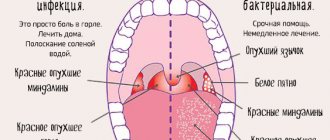Runny nose and headache, but no fever - what do the symptoms indicate?
If a person complains that he has a runny nose and a headache, then these symptoms do not indicate any specific pathology. And this condition is not always accompanied by an increase in body temperature. Therefore, the help of a specialist in this situation will be necessary, especially in cases where such signs persist for a long time.
Content
Respiratory diseases
Rhinovirus infection is one of the possible causes of a runny nose. Children with this disease develop a fever, but adults usually have a normal body temperature.
Difficulty in nasal breathing, sneezing and sore throat are characteristic manifestations of this pathology. If left untreated, a runny nose can last up to 2 weeks.
Chronic rhinitis
With this group of diseases, there are also complaints such as “headache, runny nose, but no fever.” These symptoms are most characteristic of hypertrophic and allergic inflammation of the nasal mucosa.
In the first form of rhinitis, a person is bothered by difficulty breathing, which can be constant. Sometimes nasal congestion occurs on each side in turn. If the thickened anterior sections of the inferior turbinates compress the openings of the nasolacrimal canals, conjunctivitis and lacrimation develop. In cases where the inferior nasal concha puts pressure on the nasal septum, headaches appear reflexively.
Allergic rhinitis is an inflammation of the nasal mucosa associated with contact with an allergen. Nasal congestion, excessive watery discharge and sneezing are the main symptoms. Over a long period of time, headaches, irritability, weakness, impaired sense of smell and nosebleeds occur.
Chronic sinusitis
This is an inflammation of the mucous membranes lining the paranasal sinuses. In a chronic process, there is usually no increase in temperature. The pathology is accompanied by a number of symptoms:
In the paranasal area, above the bridge of the nose, in the nose, above the eye, unpleasant sensations appear, which gradually increase over time. In the evening they intensify, and in the morning they are least pronounced. After some time, a person develops a headache. Nasal congestion, usually on both halves. It is usually permanent, but sometimes slight improvements may occur. In some people, congestion in the right and left halves of the nose alternates. The voice becomes nasal. Runny nose. Nasal discharge is usually clear mucous or yellowish-green purulent. But if the nose is very blocked, then the outflow of secretions from the sinuses is difficult, and there may be no discharge. Frequent sneezing. Weakness and general malaise. Sleep disorders.
But depending on which sinus is involved, the symptoms of the disease differ. Sinusitis can be either unilateral or bilateral. Highlight:
Sinusitis is an inflammation of the mucous membrane lining the maxillary sinus. It develops when bacteria or viruses enter the sinus from the nasal cavity in many infectious diseases affecting the respiratory tract. The pathological process can cause changes in the teeth of the upper jaw. Frontitis is an inflammation of the mucous membrane that lines the sinus of the frontal bone. The causes of development coincide with those that cause sinusitis. But the pathology is much more severe. The chronic form of the disease occurs if the outflow of sinus contents is impaired. This occurs due to hypertrophy (proliferation and increase in volume) of the middle turbinate or against the background of a deviated nasal septum. Very severe pain appears in the frontal region, and it is most pronounced in the morning. In difficult situations, the sense of smell deteriorates and photophobia occurs. Ethmoiditis is an inflammation of the mucous membrane that covers the cells of the ethmoid bone. Usually this condition occurs in conjunction with sinusitis and frontal sinusitis. Sphenoiditis is an inflammatory process of the mucous membrane that covers the sphenoid sinus. I am worried about headaches in the area of the orbit, crown, back of the head and deep in the head.
A persistent runny nose accompanied by headaches requires consultation with a specialist to clarify the diagnosis. Only after this the doctor will give the necessary recommendations for treatment.
Stuffy nose, sore throat, no temperature, headache
A sore throat is the most common symptom. Quite often, sore throat and nasal congestion occur without an increase in overall body temperature.
Unfortunately, not all people know how to help themselves in this situation so as not to suffer from more serious symptoms in the future.
What could it be?
There is a whole range of diseases in which the throat hurts, the nose is stuffy, but the body temperature does not rise. This usually happens with a cold or acute respiratory infection, when the patient’s body on its own fights the microorganisms that have entered it.
Medicine identifies several reasons for a sore throat:
- viral infections;
- irritation of the mucous membrane;
- injuries;
- muscle overstrain.
If a virus has entered the body, treatment may be limited to a course of antiviral drugs and nasal drops. In such a situation, the throat does not hurt very often, but it still interferes with eating and swallowing saliva; the nose may be stuffy, but there is no fever.
Each person has a different pain threshold, and for this reason, for some, the pain does not seem very strong, while others cannot do without painkillers.
There is another reason for discomfort - irritation of the mucous membrane of the pharynx. This most often happens with allergic reactions that lead to swelling of the mucous membrane. It could also be laryngitis, which makes it difficult to talk. At the very beginning of the pathological process, the patient will notice a sharp, cutting pain, and then his voice suddenly disappears.
When the muscles of the larynx are overstrained, the voice also breaks down, which is due to increased tone.
What you need to know
When your throat hurts and your nose is stuffy, there is no reason to call an ambulance. However, there are exceptions:
- the pain is so severe that it is impossible to swallow saliva and it flows out of the mouth;
- the throat is so swollen that it is difficult to breathe, and at the same time sounds similar to whistling and squeaking are heard.
In all other cases, a simple trip to the clinic is quite enough. We are talking about symptoms such as enlarged cervical lymph nodes, pain during jaw movements, fluctuations in body temperature, hoarseness for no obvious reason, pus or purulent plugs in the tonsils.
The following measures can be used as self-help:
- control your breathing and try to breathe through your nose;
- give up lollipops (they require you to swallow more often);
- with laryngitis, it is better to talk normally than to whisper (whispering irritates the ligaments even more);
- do not shout, avoid irritating substances, smoking (active and passive);
- gargle with saline solutions without swallowing the liquid;
- humidify the air.
Oddly enough, doctors advise eating ice cream and similar cold foods for a sore throat. This will reduce swelling, inflammation and relieve pain.
Bacterial infection
In less than half of cases, the cause of a sore throat is a bacterial infection. To make an accurate diagnosis, you will need to take a swab from the throat and culture the bacterial microflora, the degree of its sensitivity to antibiotics.
If your throat hurts, an inflammatory process develops in it. It can occur both in the pharyngeal tonsils (provoking tonsillitis) and on the mucous membranes (with pharyngitis).
When the nose is also stuffy due to a bacterial infection, the sick person will note the following symptoms:
- rapid development of pain;
- deterioration of general condition;
- increased body temperature;
- enlargement of the submandibular and cervical lymph nodes.
In such a situation, it is important to contact a general practitioner or otolaryngologist as soon as possible to make a diagnosis and begin treatment with antibiotics. In addition, frequent gargling with medicinal solutions is recommended. It has been scientifically proven that mechanical cleansing of the mucous membranes is the key to a quick recovery.
Almost any solution is suitable for treatment:
- salt (take a teaspoon of salt per glass of water);
- herbal (a teaspoon of chamomile or calendula, brewed with 100 ml of boiling water);
- drugs Octenisept, Lizobakt.
Sometimes doctors recommend lozenges, for example, Hexalize. Sprays with an antiseptic effect have proven themselves to be excellent: Tantum Verde, Hexoral, Ingalipt. For severe severe pain, you can use an aerosol with the anesthetic Strepsils-plus.
If your body temperature rises and your throat hurts even more, you should take a non-steroidal anti-inflammatory drug based on Paracetamol or Ibuprofen.
Viral infection
With a viral infection, the nose may be stuffy and the throat may be sore. For example, with an adenovirus infection, the cervical lymph nodes also become enlarged, and severe viral pharyngitis develops. Moreover, the nature of the pain can be the same as with bacterial infections.
In adult patients, the throat hurts due to mononucleosis. The discomfort is sometimes so strong that it is difficult for the patient to swallow or eat. Very often, during illness, the temperature remains within normal limits, but dehydration develops.
No matter how severe the pain syndrome is, it does not require the use of antibiotics. Viral diseases are treated only with antiviral drugs.
Symptoms of a disease of viral etiology, in which the nose is stuffy, will be:
- deterioration in general health;
- gradual increase in soreness in the throat;
- weakness in the body, pain in the head;
- loss of strength, fatigue.
Symptomatic treatment will be required.
Irritation of the mucous membrane
The nose and throat can be bothersome due to allergic reactions or as a result of exposure to tobacco smoke, dry, polluted air.
Due to irritation of the pharyngeal mucosa, the patient suffers from sore throat, watery eyes, sneezing, and excessive nasal discharge. Allergies often cause itchy skin and a dry cough.
Source: https://ormira.ru/zalozhen-nos-bolit-gorlo-temperatury-net-bolit-golova/
What to do when you have a headache, weakness and runny nose
If there is no fever, then a bath with mustard will help get rid of the first signs of a cold.
Pour hot water into a basin, add 1 tbsp. l. mustard powder and soak your feet in it for 10-15 minutes. After taking a bath, dry your feet with a towel, put on woolen socks and go to bed.
At the first sign of a cold, brew herbal tea in a thermos. To prepare it, you can use raspberry branches, linden blossom, chamomile, mint, thyme, and rose hips. Add honey, raspberry or viburnum jam, and lemon to tea. You should drink this tea as often as possible. It will help you no worse than expensive medicines and will prevent the development of complications.
On the first day of a cold, you need to take a loading dose of vitamin C. You can take several tablets of ascorbic acid, or you can increase the consumption of foods that contain this vitamin: fresh herbs, strawberries, citrus fruits. To meet your daily requirement of vitamin C, it is enough to eat 2 medium oranges. Don’t rush to throw away the peels of citrus fruits; they can also be useful for your health. You can pour boiling water over the peel and breathe over it, covered with a towel, for 5-10 minutes. It can be finely chopped and placed next to the bed to disinfect and freshen the air. You can make a decoction from the peel, which is also very useful.
If your throat hurts, rinse your mouth every 30 minutes with warm water with the addition of sea salt (1 teaspoon of salt for 1 glass). If you don't have sea salt, you can use regular salt or substitute baking soda. Various lozenges and sprays for sore throat are very useful.
If you feel weak and have a severe headache, lie down on your bed and take your temperature. You can put a leaf of fresh cabbage on your forehead, which relieves headaches well. If there is no temperature, or it is not very high, you can take your usual headache pill. If the temperature is high (more than 38º), then you should take an antipyretic drug. If severe weakness, vomiting, sharp abdominal pain, or loss of consciousness occurs, call an ambulance immediately.
2 Diet and rest during illness
If you suppress a headache with pills, after a while it comes back again. Even stronger and, as always, at the wrong time. Without taking proper measures, the pain becomes chronic and interferes with life. Find out how site readers cope with headaches and migraines using a cheap remedy.
In order for the body to cope with a cold faster, it needs to spend less energy on digesting food and other needs. Eat only easily digestible foods that contain many vitamins and beneficial microelements. The diet should consist of cereals, fermented milk products, fresh vegetable and fruit salads. To prepare meat dishes, use chicken and turkey fillet, rabbit meat, and lean beef. All fried and fatty foods should be excluded. If you have no appetite, do not force yourself, eat often, but little by little.
Ventilate the room several times a day, walk in the fresh air for 30-40 minutes daily. Be sure to change your underwear every day. If there is no fever, you can take a hot bath with sea salt and essential oils once a day.
Sore throat, stuffy nose and no fever: what to do and how to treat it
A sore throat is the most common symptom. Quite often, sore throat and nasal congestion occur without an increase in overall body temperature.
Unfortunately, not all people know how to help themselves in this situation so as not to suffer from more serious symptoms in the future.
Laryngitis
Another cause of health problems is laryngitis (inflammation of the larynx). The disease is characterized by a barking cough, wheezing in the chest, and pain in the neck. There are many causes of the disease, among the most likely are:
- overstrain of ligaments;
- frequent viral infections.
Laryngitis is very dangerous. As a result of high reactivity of the respiratory tract and repeated allergic reactions, an acute attack of suffocation, which is sometimes called croup, can begin. There is no increase in temperature during illness.
The main symptom will be hoarseness and fatigue. Purely psychological discomfort cannot be ruled out, because it is very difficult for a person to speak normally. Treatment of the disease begins with resting the ligaments. Doctors insist that you need to talk only when absolutely necessary.
Cigarette smoke will have a negative effect on the ligaments and throat, so even passive smoking should be avoided. You need to drink a lot of warm liquid and do steam inhalations. For the procedure, just bend over a pan with hot potato broth or plain water.
Alternatively, it is recommended to lock yourself in the bathroom, turn on the hot water, sit near the tap and inhale the moist hot air. You should be extremely careful, since the temperature of the water is very important; the steam should be moist, warm, but not scalding.
Correct treatment
Unfortunately, today there is no remedy that can treat a sore throat, even if there is no fever. The use of a strong local anesthetic will not help, since the patient will not be able to drink or eat after this.
The best option is treatment with drugs based on substances:
- phenol;
- dyclonine;
- benzocaine.
These components cause slight numbness in the throat, reducing pain sensitivity in it.
Lollipops made from menthol will help relieve pain. They help cool the throat, soften the tissues, relieving soreness. But it should be understood that lollipops do not have a therapeutic effect and will not eliminate the cause of the problem.
For a sore throat, the doctor will prescribe antibacterial and antiseptic aerosols. They contain components that quickly stop the activity of pathogenic microflora. It is best to use single-component medications, as there is a risk of an allergic reaction. If you treat your throat with complex drugs, the likelihood of complications of the disease increases.
Also, when the throat hurts, lozenges are prescribed. They are usually divided into several groups:
- containing substances that inhibit viruses and bacteria (Hexaliz, Lysobact);
- containing non-steroidal anti-inflammatory components (Strepfen);
- containing lysates of pathogens that often provoke tonsillitis and pharyngitis (Imudon). Thanks to them, the body activates local immunity. Medicines in this group are indicated for chronic and indolent forms of ailments;
- containing plant components. Natural substances improve blood flow and promote mucus formation, alleviating the symptoms of the disease.
It should be remembered that when your throat hurts and it becomes difficult to swallow, dehydration can begin very quickly. If the patient's body temperature begins to rise, the likelihood of water loss only increases. This fact must be taken into account and the fluid balance in the body must be replenished.
When your nose is stuffy, your doctor will recommend one of a number of medications:
- Naphazolin, Sanorin, Naphthyzin;
- Oxymetazoline, Nazol, Nazo-spray, Nazivin;
- Tetrizoline, Tizin;
- Xylometazoline, Tizin Xylo, Galazolin, Xymelin, Otrivin, Dlynos, Xylene, Snoop, Rinonorm.
If your body temperature begins to rise, you need to take a drug based on Paracetamol, Ibuprofen or Aspirin. The video in this article will tell you what to do if you have a sore throat.
Source: https://stopgripp.ru/bolezn/ango/bolit-gorlo-zalozhen-nos-net-temperatury.html
Runny nose, sore throat and temperature 37-38: how to treat
A sore throat, a temperature of about 37, a cough and a runny nose - all this indicates that an infection has entered the body.
The patient's condition is weak, he is constantly tired, has no appetite, and may have a headache.
The worst thing is that many people get sick all season; the symptoms may become weaker for a while, but then return again.
What diseases can these signs be symptoms of and what should be done? Do I need to see a doctor and take sick leave from work, or can I heal myself?
How dangerous is it to suffer such a cold on your feet - after all, the temperature is not very high?
Viral infection or a common cold?
They need to be treated with different medications and methods, so it is important to establish what exactly caused the disease. One of the indicators that will help determine the type of infection is the patient’s body temperature.
A temperature of about 37 degrees or slightly higher is called low-grade fever and usually indicates that the patient has contracted the virus.
A bacterial infection is characterized by an acute inflammatory process, in which the temperature rises to 38 degrees and above. Also, the thermometer readings can be kept at 37 for a long time in case of chronic ENT diseases.
This, of course, is not a strict rule; even a common cold or flu sometimes begins with a strong increase in body temperature, and only then a cough, runny nose and sore throat appear. ARVI or acute respiratory infections - this can only be accurately determined with the help of laboratory tests. But what to do until the tests are ready? It is important to start treatment as early as possible.
A viral infection is recognized by the following typical signs:
Seasonality - a bacterial infection can strike all year round, but influenza and its varieties in our region - mainly from December to February. The disease has a distinct onset and rapid progression - symptoms appear within a few hours after contact with a sick person, a maximum of 48 hours. First, a sore throat, headache and temperature up to 37 or 37.5 degrees, chills, weakness appear, then a runny nose and cough.
Infections caused by viruses cannot be treated with antibacterial drugs. Therefore, you should not immediately swallow handfuls of tablets from your home medicine cabinet - this will only undermine your already weakened immune system and delay treatment.
Often the temperature is 37, a runny nose and cough persist for up to several weeks precisely because the patient immediately took a “loading” dose of a variety of medications and suffered the disease on his feet. In this case, it will not be easy to cure him.
What to do if you have a sore throat, runny nose and cough
How to behave correctly at the first signs of ARVI in order to get back on your feet as quickly as possible and prevent complications? At first glance, it is not clear how a sore throat and runny nose can be associated with the digestive organs, heart and blood vessels, but this is so.
Advanced influenza causes complications such as pneumonia, rheumatism, otitis media, dysfunction of the musculoskeletal system, and pathologies of the excretory system.
Therefore, even at a temperature of 37, which many do not consider serious, requiring hospital and bed rest, you should call a doctor and take the following measures:
Maintain bed rest, limit contact with others as much as possible, and do not go outside; Drink more liquid, but not soda and coffee, even with milk, but tea and decoctions of medicinal herbs, natural juices, compotes and fruit drinks. You can drink rosehip or cranberry syrup dissolved in still mineral water; Ventilate the room and humidify the air more often; Monitor your body temperature - if it becomes above 37 and continues to rise, you should immediately call a doctor.
Your doctor will tell you how to treat cough, snot, and sore throat due to ARVI. What not to do before he arrives:
Take aspirin at any temperature. Attend work, college, go shopping. Go on a diet or introduce new foods to your diet. Drink alcohol and smoke.
If your throat is very sore, you can gargle it with decoctions of chamomile, sage, oak bark, furatsilin or baking soda. If you have a severe runny nose, it is permissible to put vasoconstrictor drops into your nose. But in no case should you exceed the dosage specified in the instructions for use.
To maintain immunity, it is very useful to take multivitamins and eat as many fresh vegetables and fruits as possible.
If the condition worsens, severe headaches and cramps, skin rashes, vomiting, shortness of breath, shortness of breath, attacks of weakness up to loss of consciousness appear, urgent hospitalization of the patient is necessary.
How to treat a sore throat
This symptom is very unpleasant, in addition, if you do not treat a sore throat, you can progress the disease and then you will have to suffer for several more weeks, or even months.
The method of eliminating sore throat is chosen depending on its cause.
Pharyngitis - a strong, cutting soreness bothers you, your voice is hoarse, and it is very painful to swallow. Pharyngitis is a complication of a cold or flu. It is treated with special sprays, lozenges, rinses and warm drinks: Laryngitis - symptoms are similar to pharyngitis, but the voice often disappears completely, the pain in the throat is very strong and constant. Unlike pharyngitis, laryngitis can be caused not only by infection, but also by mechanical damage to the mucous membrane, loud singing, and smoking. The treatment is identical, it is important not to strain the vocal cords, not to smoke, not to eat spicy and sour foods; Sore throat - with this disease, a white coating appears on the surface of the larynx and tonsils, the temperature can rise above 38.5, and general symptoms of intoxication appear. It is imperative to remove plaque using rinses and inhalations; often you cannot do without antibiotics, which should only be prescribed by a doctor.
With proper treatment, the patient recovers completely within 7-10 days.
Sore throat, runny nose, dizzy
As a rule, a minor headache accompanied by redness in the throat is perceived by people as a disease that does not require serious treatment.
As a last resort, a person can take an aspirin tablet and gargle with warm chamomile tea.
But do not forget that such extremely dangerous diseases as tonsillitis and purulent tonsillitis can begin with precisely such symptoms.
What happens in the body?
Twenty people with constant headaches can make an appointment with a neurologist, and each will have different symptoms and causes of this unpleasant but extremely common illness.
Headache can be caused by tension, stress, pressure surge, vascular disorders, swelling and inflammation of tissues, and general intoxication of the body.
All these reasons cause a disruption in the blood supply to the brain, as a result of which the main organ does not receive sufficient amounts of oxygen, trace elements and nutrients (primarily glucose).
With acute spasms and tissue swelling, brain cell death may occur.
The body reacts to this with pain.
Causes
If a person has a headache and a sore throat at the same time, there may be several reasons. Most often this is an infectious disease , especially if the symptoms are accompanied by an increase in body temperature and general lethargy, chills, and lack of appetite.
In some cases, such double pain may indicate the onset of a seasonal or periodic allergic reaction, as well as pathologies of the nasopharynx. What are the most common causes of this disease?
Tonsillitis
With tonsillitis, the infection affects the throat and nasopharynx. A severe runny nose, nasal congestion, acute headache and a very strong, cutting pain in the throat appear.
https://www.youtube.com/watch?v=IQ_K6mb8xcw
With tonsillitis, a heavy coating appears on the tonsils, all the depressions in the tonsils are filled with a cheesy discharge with an extremely unpleasant odor, and purulent plugs also appear.
Also, with tonsillitis there are usually symptoms such as:
- strong bad breath;
- body temperature rises above 37.5-38 degrees;
- the tonsils swell, the nasopharynx becomes blocked, the voice becomes hoarse;
- extremely difficult to swallow;
- lymph nodes are enlarged.
Often the pain in the throat even radiates to the head.
Treatment must be comprehensive and must include antibiotics.
Important! If the patient, in addition to tonsillitis, is allergic to medications, pollen or dust, a complication may be Quincke's edema, that is, the person simply will not be able to breathe, or even anaphylactic shock.
Allergy
The mechanism of action of substances that cause allergies in certain people is very complex.
When an allergen enters the body, the immune system produces antibodies that try to remove the “foreign” substance from the body.
As soon as a person suffering from an atypical reaction inhales dust, fur, or takes inappropriate antibiotics or vitamins, a primary defensive reaction occurs.
It manifests itself in the form of redness in the throat, swelling of the nasopharynx, general weakness, tears and a throbbing headache.
What to do for prevention
To avoid getting sick again, you should follow preventive measures. First of all, the general condition of a person is influenced by the level of immunity, which performs a protective function. To improve immune protection, it is necessary to regularly carry out hardening procedures (physical exercise, walks in the fresh air, adequate sleep and nutrition).
The use of nicotine has a negative impact on the walls of blood vessels and the condition of all organs. When the nose and head are affected, smoking leads to increased blood pressure and poor circulation, causing bleeding.











